A Basic How-To For Healing Yoga Poses
Research shows regular yoga practice can effectively reduce chronic pain — addressing both physical aspects and emotional.[1] Even in the short term, studies suggest practicing yoga can help treat pain-related conditions including back pain, arthritis, and migraines. While completing a yoga practice of more than one pose will likely provide added pain-reducing benefit — including a possible reduction in the stress and anxiety that often comes with acute pain — the following poses are a great start for some of the most common aches.
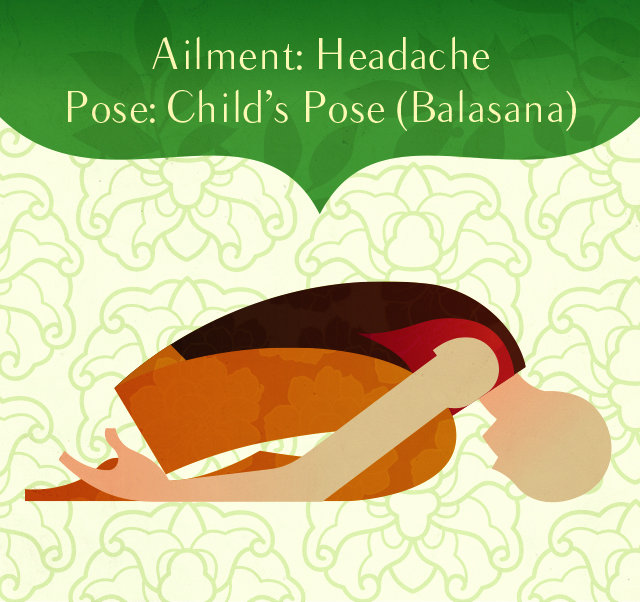
Ailment: Headache
Pose: Child’s Pose (Balasana)
While many poses are known to reduce the tension that causes headaches before they happen, this pose is great when the ache has already sprung. Child’s pose just slightly inverts the body for increased blood circulation to the head, helping to relieve tension.
How to: Kneel on the floor, big toes touching, knees at hip-width. Exhale and gently lower the torso between the thighs, resting the forehead to the mat. Rest the arms to the sides of the body (palms up), or extend them in front of the body (palms down) for a great shoulder opener. Rest in this pose for 30 seconds to a few minutes, gently “melting” into the floor with each breath.
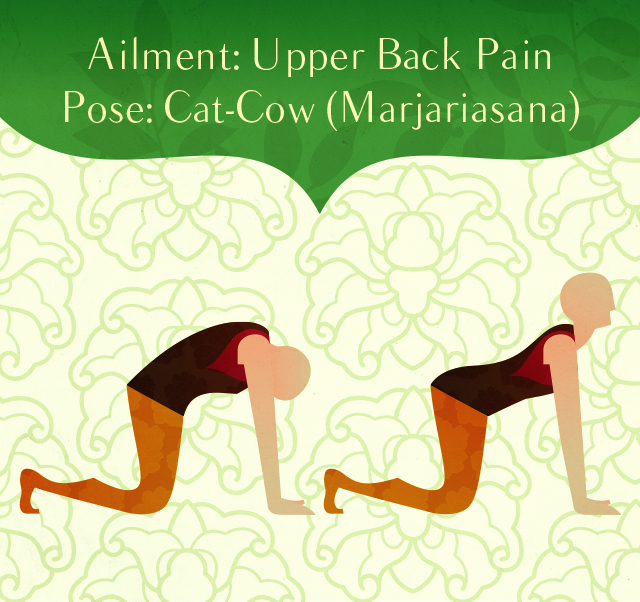
Ailment: Upper Back Pain
Pose: Cat-Cow (Marjariasana)
This pose is commonly used at the start of a practice to stretch and gently massage the back and neck muscles. Arching up and down helps relieve tension and increase mobility in the spine.[2] Cat-Cow also helps prepare the spine for more advanced back bends.
How to: Start in a tabletop position with the hands and knees on the floor, the spine neutral. On an inhale, press through the hands to round the spine and gently drop the head for cat pose. Really arch the upper back, lowering chin to chest and gaze toward the bellybutton, for a full stretch. On the exhale, lift the chest, gaze upward, and allow the upper spine to slightly release downward (the tailbone should tip up toward the ceiling) for cow pose. Repeat four to six times, transitioning with each breath.
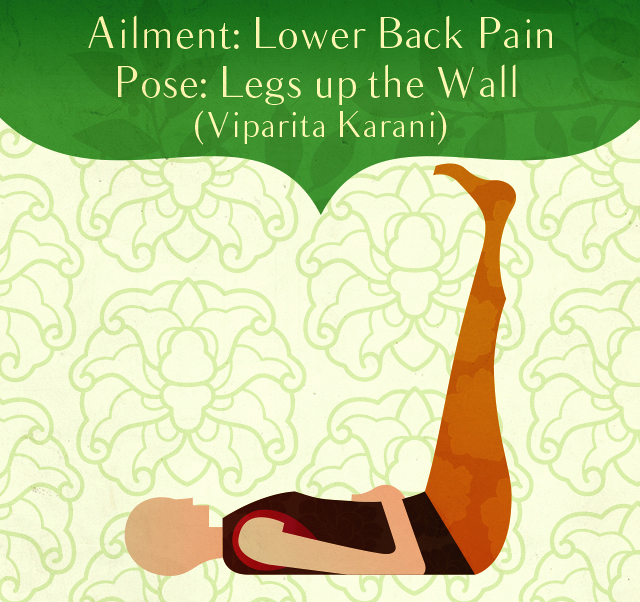
Ailment: Lower Back Pain
Pose: Legs up the wall (Viparita Karani)
This relaxing and restorative inversion is a great way to end a long day (especially for those who are on their feet all day). Resting the extended legs on a wall gently stretches the hamstrings, relieving pressure in the lower back.
How to: Start in a seated position next to a wall, the feet on the floor in front of you, left side of the body making contact with the wall. Gently lie down on the back then pivot at the hips until the backs of the legs are pressing against the wall, perpendicular to the floor. The legs should be as straight as is comfortable, but if the full extension isn’t there just yet, start with a little bend in the knees. Scoot the body as close to the wall as possible (the bottom can make contact). Soften the upper body and allow yourself to sink the weight of the legs into the wall, hands may rest on the belly. Stay in the position for 2-15 minutes, and gently roll to one side before returning to standing. Note: Some people feel more comfortable in this pose with a prop, like a pillow, bolster, or block, underneath the low back and buttocks.
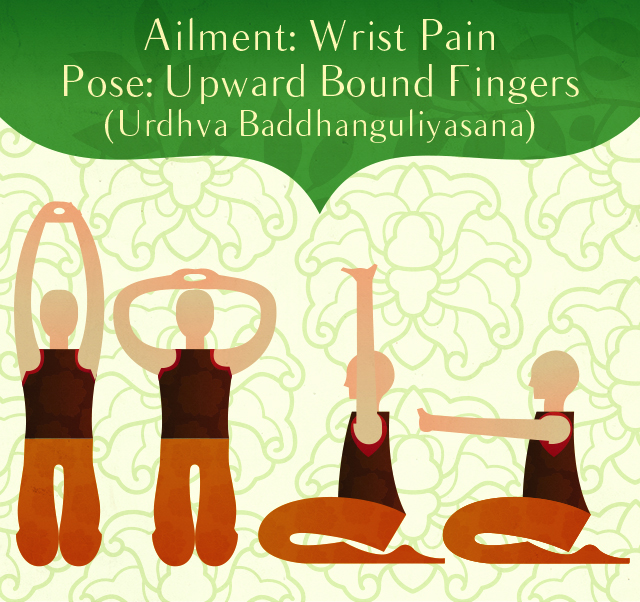
Ailment: Wrist Pain
Pose: Upward Bound Fingers (Urdhva Baddhanguliyasana)
A 9-5 office job can do a number on the body, especially the wrists with continuous keyboard and mouse use. Practice this one at home or on the job to maintain flexibility in the wrists.
How to: This pose can be practiced seated or standing. Inhale and raise the arms straight in front of the body (perpendicular with the torso). Bend the wrists and interlock the fingers, the thumbs touching one another. Exhale and roll the palms away from the body, keeping the fingers interlocked. If fully extended arms create any discomfort, breathe into the pose while slowly straightening the arms. With another exhale, bring the arms (fingers still bound) overhead so the palms are parallel with the ceiling. Hold the pose for 30 seconds to a few minutes, or with each breath, alternate extending the arms in front of the body and above the body (hands bound throughout).
Ailment: Shoulder Pain
Pose: Downward-Facing Dog (Adho Mukha Svanasana)
This full body energizer stretches everything from the calves and hamstrings to the back, shoulders, and forearms. You will see downward dog in many styles of yoga, as it is part of the traditional sun salutation sequence.[3]
How to: Start in a tabletop position with the hands shoulder width apart and knees on the floor, the spine neutral. Extend through the arms, lift the knees off the floor, exhale, and press the pelvis toward the ceiling. Gently pedal through each leg — slightly straightening one, bending the other. Press the upper body up and away from the hands throughout the pose, gradually releasing through the upper back. Think about pulling the shoulder blades away from the ears to open through the shoulders and rotating the elbows slightly inward rather than bowing out. Slightly relax the head and neck and gaze toward the navel.
Ailment: Hip Pain
Pose: Happy Baby (Ananda Balasana)
While it may feel a little silly at first, this calming pose does wonders for the lower back and hips. Great for the end of a practice or even before bed, this pose requires little effort compared to many standing hip-openers.
How to: Lie on the back. On an exhale, bend the knees to the sides of the body. Inhale then grip the outside edges of the feet (elbows inside of the knees). If holding onto the feet directly is uncomfortable, place a strap on each foot to add length. Gently pull the knees down and toward the armpits. Flex the feet and keep the heels stacked over the knees (the lower half of each leg should be fairly perpendicular to the rest of the body). Hold the pose for 30 seconds to a few minutes. Feel free to add some creativity by rocking side to side while bringing the thighs toward the floor.
Ailment: Knee Pain
Pose: Warrior I (Virabhadrasana I)
While certain yoga poses — such as those in the warrior sequence, for instance — help strengthen the muscles around the knee joint (protecting it from future injury), they may also cause discomfort for those experiencing knee pain. [4] But with the proper form and a multitude of modifications, standing poses can still be incorporated into a practice to work up that strength.
How to: Begin at the top of the mat. Step the left foot back (about four to five feet behind you). The front foot should point straight ahead, parallel to the mat; the back foot should point to the left corner of the mat, slightly diagonal. Think about dropping the tailbone toward the mat, lowering into the front, bent leg. Scoop the pelvis so the torso becomes more perpendicular placement compared to the mat. On an exhalation, raise the arms overhead. Remember to engage the thigh muscles of both legs and make sure the front knee is above the ankle (try not to let it track forward, backward, inward, or outward) to prevent knee pain.
Ailment: Digestion Pain
Pose: Wind-Relieving Pose (Pawanmuktasana)
As it’s name suggests, this pose helps release abdominal gas, which can cause sharp pain and discomfort. Curling the body into a tight ball helps massage the intestines and aid in digestion.[5]
How to: Lie on the back, feet together, arms to the side. With an exhale, bring the right knee toward the chest, gently pulling it toward the body. Inhale and with the next exhale touch the knee to the forehead (if the body doesn’t allow the head and knee to make contact, just work toward pressing the leg gently in toward the belly). Take a few deep breaths in this position. Return to start then repeat the movement with the other leg then with both legs together.
With any yoga pose, it’s important to work within your own range of limits and abilities. If you have any known medical conditions, have a conversation with your doctor before practicing yoga.
[1] http://www.ncbi.nlm.nih.gov/pmc/articles/PMC2936076/#!po=5.55556[2] http://www.artofliving.org/yoga/health-and-wellness/yoga-for-neck-pain
[3] http://www.yogawiz.com/yoga-poses/yoga-asanas/downward-facing-dog-pose.html
[4] https://yogainternational.com/article/view/yoga-therapy-for-your-knees1
[5] http://www.artofliving.org/in-en/yoga/yoga-poses/wind-relieving-pose
Take the First Step Towards Pain-Free Living Today

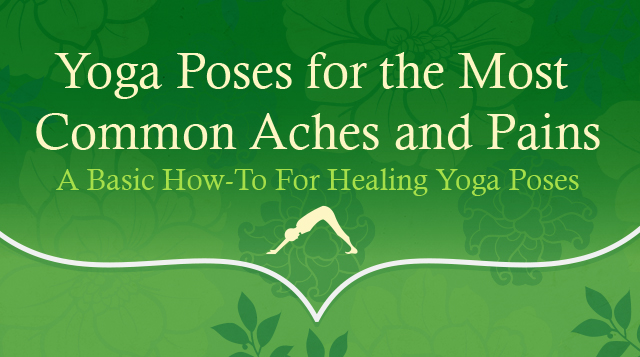
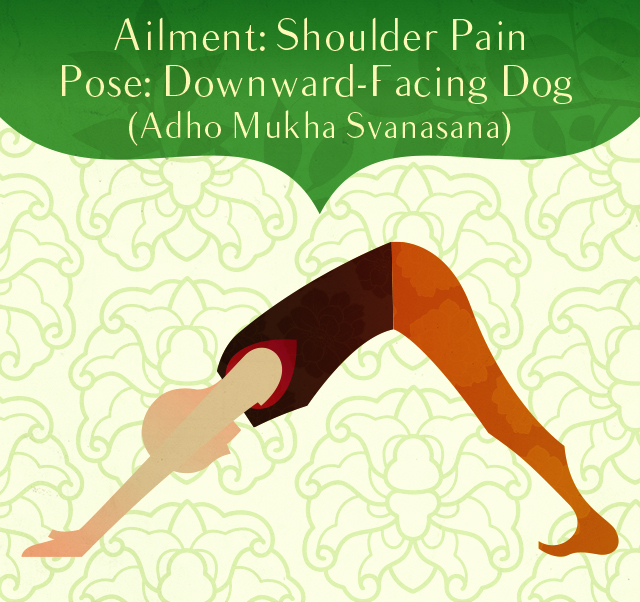
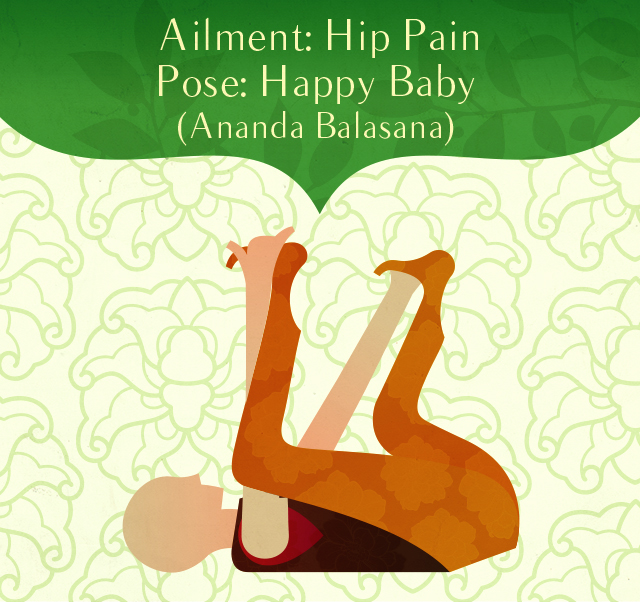
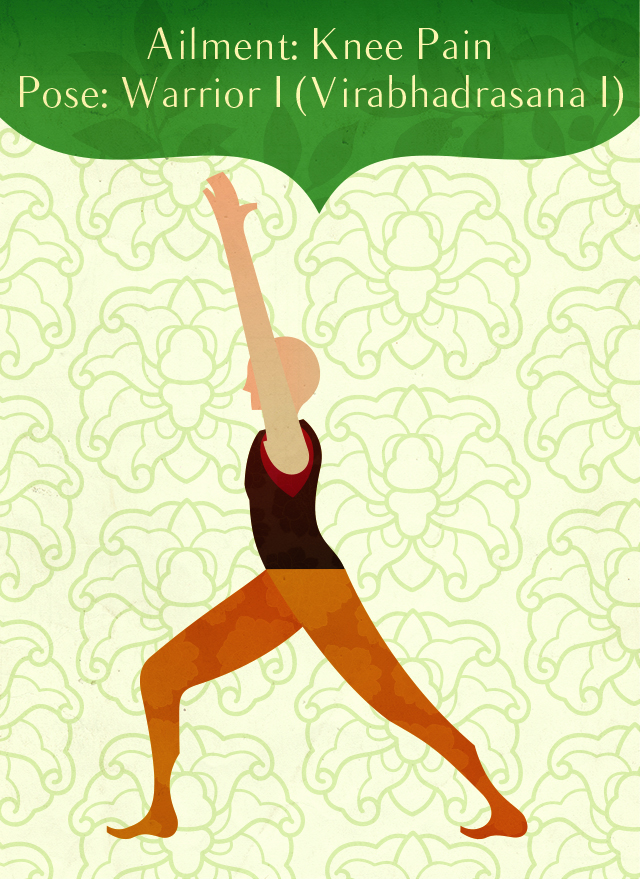


I absolutely hate planking, but I’m trying the plank challenge to try and strengthen my lower back, Wish me luck!
Very well documented, beautiful visual presentation and a very well researched piece on yoga poses for aches and pains. Good job guys.
Hey AJ! Nice Post. Thanks for sharing the information. The presentation is really nice. 🙂
Nice Post. Thanks for sharing the information